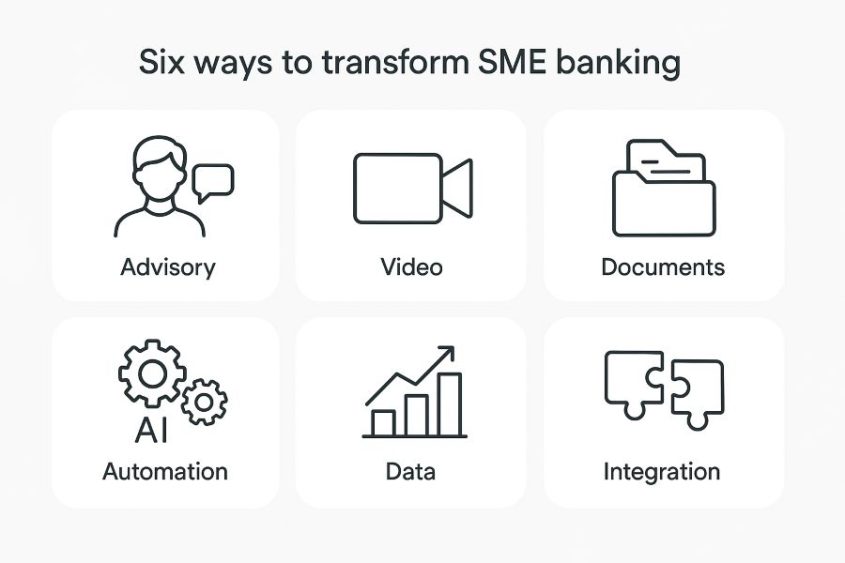According to the SME Performance Review 2023/2024, 78% of business owners believe banking processes waste their time, and 64% are ready to switch banks in search of faster, simpler services.
For banks, that’s not a threat — it’s an opportunity. In this article, we explore six strategic areas where banks can elevate their SME offering — combining personalized advisory, automation, video services, and smart data usage to meet the real-world needs of business clients.
Table of Contents
1. Branches as advisory centers for SMEs – personalization instead of standard service
Despite the growing digitization of banking services, 53% of SME owners still prefer face-to-face contact for key financial decisions.
To address this, banks should increase the involvement of advisors in digital channels. The ability to consult an advisor, discuss individual needs, or negotiate financing terms are aspects highly valued by entrepreneurs.
Implementing online booking systems and video advisory services can reduce the need for in-branch visits by up to 40% while accelerating processes and maintaining high satisfaction levels.
When given a choice between an in-branch meeting and an online consultation, 70% of clients opt for the remote option — proof that convenience and personalization can go hand in hand.
2. Video as a key to faster and more convenient service
Video calls are one of the most effective solutions for streamlining SME customer service. They allow clients to manage key financial matters with fewer branch visits, translating into time savings and greater convenience.
Benefits of using video in SME banking include:
- Reduced service time – video consultations can shorten request processing time from two days to just three hours. Clients save five to six hours in travel time alone.
- Higher conversion rates – SMEs using video consultations are 25% more likely to complete financing applications successfully.
For banks, video channels reduce physical traffic in branches, increase advisor availability, and open the door to hybrid client relationships.
3. Secure and fast document exchange – reducing paperwork
SMEs often need to submit multiple documents, which is time-consuming and prone to delays — especially with traditional methods like email, mail, or in-person delivery.
Digitizing document exchange within the bank’s ecosystem can reduce waiting times by five to seven business days.
Key tools and benefits:
- Electronic signatures, reducing approval times from days to hours.
- AI-powered data extraction, which transfers data to internal systems and reduces human error by up to 90%.
- Secure cloud-based exchange, eliminating the need for physical visits.
Streamlining documentation benefits both parties — it enhances the client experience and significantly lowers the operational burden on bank staff.
4. Process automation – saving time
Manual processes remain one of the biggest bottlenecks in SME banking. On average, 50% of service time is spent on tasks that could be automated.
Using artificial intelligence and machine learning helps banks deliver faster decisions, better product recommendations, and fewer errors.
Automation in practice:
- AI-driven credit decisions, cutting average review time from seven days to just 24 hours.
- Chatbots, which reduce simple inquiries to human advisors by up to 40%.
- AI assistants for employees, speeding up data retrieval and internal communication.
This not only boosts SME satisfaction — it also frees up advisors to focus on more strategic tasks and complex cases.

5. Leveraging data and analytics for personalized services
Banks have access to vast amounts of data — and using it wisely means better service and better results.
Here’s how data can power smarter SME banking:
- Transaction analytics – allows segmentation and prediction of needs, enabling proactive offers (e.g., business cards, credit lines).
- Precision recommendations – tailored products based on customer history, industry, and behavior. Even voice data from conversations can uncover hidden opportunities.
- Risk management – improved fraud detection and more accurate credit scoring, reducing financial exposure for banks.
Smart data usage makes banking not just reactive, but strategically one step ahead of client needs.
6. Better technology integration
Technology silos are one of the biggest blockers to efficiency. Advisors often struggle with disconnected systems that require redundant data input.
Breaking these silos should be a strategic IT priority for banks.
Key areas of integration:
- Omnichannel experience, ensuring that customer interactions — online, mobile, or in-branch — are unified and consistent.
- ERP/accounting integrations, helping SMEs manage finances seamlessly across platforms.
- Open APIs and open banking, offering access to external fintech services within a single banking ecosystem.
Explore real success stories from ING SME transformations
Conclusion
The future of SME banking lies in combining innovative technology with a deeper understanding of customer needs.
Banks that embrace digitization, automation, and personalization will not only stay competitive — they’ll build stronger, more lasting relationships with small-business clients.
This transformation improves service quality, strengthens loyalty, and supports long-term economic growth.
Contact us! Let’s talk about how we can make SME banking better — together.



